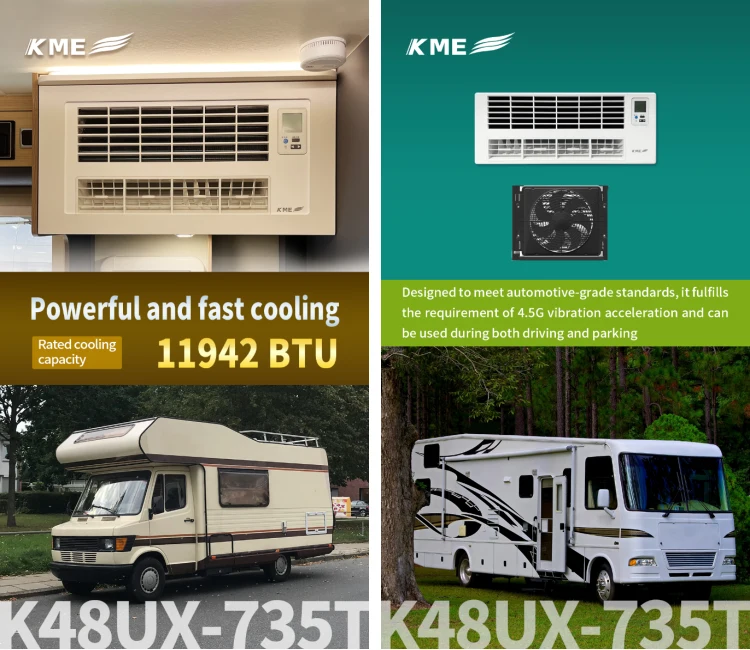When traveling in an RV, the right temperature and humidity are crucial to maintaining a comfortable and healthy interior environment. However, because RVs have limited space and are greatly affected by the outside climate, humidity control often becomes a challenge. High humidity can not only cause damage to interior materials and mold growth, but can also cause discomfort to occupants, so having an effective dehumidification system is particularly important. The dehumidification function of the RV air conditioner is the key to solving this problem.
The working principle of an RV air conditioner is similar to that of a traditional home air conditioner, by circulating refrigerant between the evaporator and condenser to achieve heat exchange. During this process, the humid air will contact the low-temperature evaporator, and the water vapor will condense into water droplets when cooled, thereby achieving the separation of moisture in the air. This collected moisture is typically directed to the exterior of the RV or collected in a specialized collection tank for manual dumping.

The impact of the dehumidification function on the living environment of an RV cannot be underestimated. First of all, it can effectively reduce indoor humidity, provide a dry environment, and reduce the growth of bacteria and mold caused by excessive humidity. This is necessary to protect the furniture, carpets and walls inside the RV. Secondly, moderate humidity levels can increase occupant comfort and avoid physical discomfort caused by dampness, coldness or dampness and heat. In addition, a good dehumidification system can prevent window fogging, maintain good visibility, and ensure driving safety.
The dehumidification function of modern RV air conditioning systems is usually combined with the cooling function, and the user can adjust the settings according to needs. Some high-end RV air conditioners are even equipped with humidity sensors that automatically monitor indoor humidity and adjust their operation to maintain a constant humidity level. This intelligent management method greatly improves the convenience of use and also saves energy consumption.
In addition to standard refrigeration-based dehumidification, some RV air conditioning systems use other technologies to enhance dehumidification. For example, desiccant dehumidification technology uses desiccant to absorb moisture in the air and is suitable for low temperatures or environments that require efficient dehumidification. Although this technology costs more, it provides more stable and efficient dehumidification performance.
When using the dehumidification function of your RV air conditioner, correct use and maintenance are key to ensuring its efficiency and longevity. Regularly cleaning the air conditioner's filter and evaporator to ensure they are not clogged with dust and dirt can improve dehumidification efficiency and save energy. At the same time, it is also important to check whether the drainage pipe is clear to prevent water from backing up and entering the car.
There are some additional steps you can take to maximize the dehumidification effect of your RV air conditioner. For example, when traveling in humid weather, keep the windows closed as much as possible to prevent humid air from entering the car. Use insulated curtains or sunshades to reduce additional moisture from direct sunlight. Additionally, keeping your car ventilated can also help disperse moisture, but should be used with caution in humid environments.
As a professional RV air conditioning company, we are committed to providing users with high-quality products and excellent services. The design and performance of our RV air conditioning dehumidification functions have been carefully developed and tested to ensure stable and reliable working results. Whether it's hot summer or humid rainy season, our RV air conditioner dehumidification function can provide you with a comfortable and dry travel environment. Choose our RV air conditioner to make your RV trip more enjoyable and comfortable!
In short, the dehumidification function of the RV air conditioner is an important tool to maintain the comfort and health of the interior environment of the RV. By understanding its working principle and correct use and maintenance, RV users can effectively control the humidity in the vehicle and enjoy a comfortable travel life whether in hot and humid summer or cold and humid winter. With the advancement of technology, future RV air conditioning systems will be more intelligent and efficient, providing users with a more perfect living environment.
How do RV air conditioners work and what size air conditioner do you need for your RV?
Analyze the key factors that affect the price of RV air conditioner
Essential for self-driving travel: How to choose an RV air conditioner that's right for you?
Stay cool on the road: RV air conditioner care and maintenance guide
How to improve the cooling effect of RV air conditioner?
RV air conditioner energy consumption and energy saving tips
What are the factors that affect the service life of RV air conditioners?
Is the RV air conditioner heating effective?
What do you know about the precautions for using RV air conditioners?
RV air conditioning problems and solutions: the key to ensuring comfortable travel
Analysis of the functions of RV air conditioners: bringing comfort and convenience to RV travel
RV air conditioning refrigerant selection and replacement guide
RV air conditioner energy conservation guide: usage tips and energy saving strategies
How to choose a quality RV air conditioners supplier?
Recommended installation and location layout of RV air conditioner
How to effectively control the noise of your RV air conditioner
How to choose and maintain an air circulation system for your RV air conditioner?
mia
c.yd@kme-cn.com
